It’s another busy day at the Māngere Town Centre.
But one particular corner of this small bustling mall is bursting with colour and laughter as elderly women, adorned with beautiful flowery ‘ei katu garlands, sew and weave materials in much the same way that their ancestors would have.
Among the vibrant group is tivaevae expert and Cook Islands heritage artist Tukua Turia who knows too well the significance of traditional quilt-making and stresses the importance of preserving and passing on the knowledge of creating it.
“Treasure them … the good work,” she says of the cultural craftsmanship that’s laid out around her.
An ‘ei katu is an arrangement of flowers worn on or around your head like a crown. The tivaevae is another treasured item in the Cook Islands culture, usually a quilt, that is stitched and hand-sewn, by older women within the family.
And thanks to the Ōtara-Papatoetoe and Māngere-Ōtāhuhu Local Board, the wider community has been able to learn how to make their own tivaevae and ‘ei katu.
“It’s important … that’s our hope, to learn and not to forget what our grandmothers, our grand-aunties taught us, right? So we picked it up,” says Turia.

Turia is self-taught and has been sewing and designing since her twenties. Her work has been commissioned for Te Papa and Auckland Museum, and in the 2019 New Year’s Honours she was made a Member of the New Zealand Order of Merit for her services to Cook Islands art and culture.
“This one here, we do it, you know, all week [for] Cook Islands language, " she says of the free sessions.
Turia also runs twice-weekly workshops as part of her Creative Polynesian Arts Mamas group.
“We keep on doing the same thing, you know but different patterns. We don’t do the same pattern. I don’t allow them to copy the pattern because you’ve got to do free hands then you get more,” says Turia of her regular classes.
Turia says the art of tivaevae is important for its cultural knowledge to be passed on.
“To me, it’s something that I will never, you know … forget to pass on to my kids and take them … that’s why I want to do it. It’s important for our young generations … [and] that’s what Cook Islands people like to do. It’s important. That’s our culture.”
She says the older the tivaevae, the more culturally important it is especially because the creators of these patterns may have passed.
“They’re gone. The patrons, the people, the ladies … the ones who made it like grandmothers. They have passed on. That’s why you have to look after them, treasure them.”
Ōtara-Papatoetoe Local Board chair Apulu Reece Autagavaia says the workshops are part of the board’s commitment to sustain Cook Islands culture.
“Language is a central part of our identities as people of the Pacific diaspora. Of course, some are more fluent than others but we are all on a journey.
“Language weeks are one of the ways our Pacific communities can highlight the importance of the language and culture but also to share with others. So, it’s not just about the languages, but the customs and values behind our cultural identities.
“The OPLB is proud to support tivaevae and ‘ei katu workshops as a way to reconnect our Cook Islands youth to their mama and papa, and for the wider community. We even had a Chinese school visit and try their hands at tivaevae.”
Māngere-Ōtāhuhu Local Board chair Tauanu’u Nick Bakulich adds, “It is important to support these workshops to ensure that our precious cultures are not only showcased but kept alive for the future generations.”




